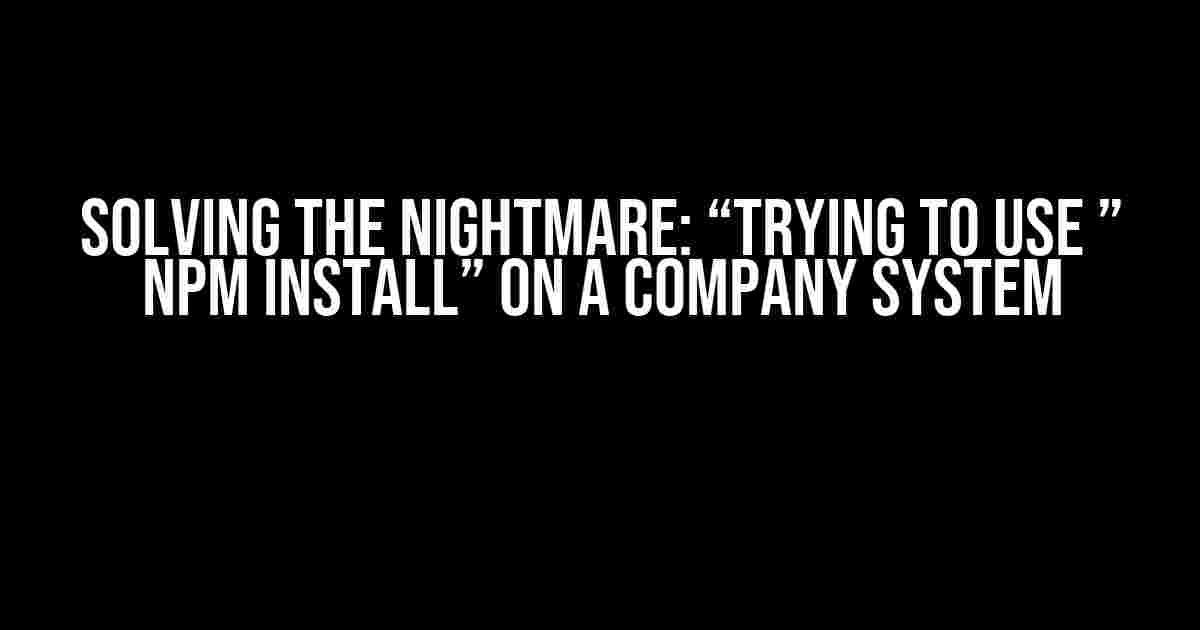Are you stuck with the frustrating error “Trying to use ” npm install” on your company system? Don’t worry, you’re not alone! Many developers have faced this issue, and we’re here to guide you through a step-by-step solution to get you back on track.
The Problem: Understanding the Error
The error message “Trying to use ” npm install” typically occurs when there’s a conflict between the company’s system settings and the way you’re trying to install a package using npm (Node Package Manager). This can happen due to various reasons, including:
- Company firewall restrictions
- Proxy settings issues
- npm configuration problems
- Network connectivity problems
Before we dive into the solutions, let’s try to identify the root cause of the problem. You can follow these steps to diagnose the issue:
npm config ls -l: Run this command to check the npm configuration settings. Look for any unusual or incorrect settings that might be causing the issue.npm install --verbose: Run this command to get a more detailed output of the installation process. This can help you identify any specific error messages or clues.- Check company firewall and proxy settings: Reach out to your IT department or system administrators to inquire about any restrictions or settings that might be blocking the installation.
Solution 1: Configuring npm to Bypass the Company Proxy
If your company uses a proxy server, you might need to configure npm to bypass it. You can do this by setting the proxy and https-proxy variables:
npm config set proxy http://your companys proxy server:port
npm config set https-proxy http://your companys proxy server:portReplace http://your companys proxy server:port with the actual proxy server address and port number provided by your company.
Solution 2: Using npm with a Custom Registry
If the problem persists, you can try using npm with a custom registry. This method allows you to install packages from a specific registry instead of the default npm registry:
npm config set registry http://your companys custom registryReplace http://your companys custom registry with the actual URL of your company’s custom registry.
Solution 3: Disabling the Company Firewall or Proxy Temporarily
If the above solutions don’t work, you can try disabling the company firewall or proxy temporarily to see if it resolves the issue. However, please note that this should be done with the permission of your IT department or system administrators:
Disable the company firewall or proxy
Try running npm install again
Re-enable the company firewall or proxySolution 4: Using a Virtual Private Network (VPN)
If you’re working remotely, you can try using a Virtual Private Network (VPN) to bypass the company firewall or proxy restrictions. This will allow you to connect to the company network as if you were on-site:
Connect to the company VPN
Try running npm install againTroubleshooting Common npm Install Issues
In addition to the “Trying to use ” npm install” error, you might encounter other issues when trying to install packages using npm. Here are some common problems and their solutions:
| Error Message | Solution |
|---|---|
| npm ERR! code EPERM | Run the command with administrator privileges (sudo npm install) |
| npm ERR! code ECONNREFUSED | Check your network connection and try again |
| npm ERR! code ETIMEDOUT | Increase the timeout value (npm config set timeout 10000) |
| npm ERR! code ENOENT | Check the package name and version, and try installing again |
Conclusion
The “Trying to use ” npm install” error on a company system can be frustrating, but by following the steps outlined in this article, you should be able to resolve the issue. Remember to diagnose the problem, configure npm accordingly, and try different solutions until you find the one that works for you. If you’re still stuck, don’t hesitate to reach out to your IT department or system administrators for further assistance.
Happy coding!
Frequently Asked Question
Are you stuck with the error message while trying to use “npm install” on your company system? Don’t worry, we’ve got you covered! Here are some frequently asked questions and answers to help you troubleshoot the issue.
Q1: What could be the reason behind the error message?
One of the most common reasons for the error message is that your company’s system may have restricted access to npm registry or npm packages. It’s also possible that your system’s firewall or antivirus software is blocking the installation process.
Q2: How can I check if my company’s system has restricted access to npm registry?
You can try running the command `npm config get registry` to check the current npm registry. If it’s not set to the default registry, you can try setting it to the default registry using the command `npm config set registry https://registry.npmjs.org/`. Then, try running `npm install` again to see if it resolves the issue.
Q3: What if I’m still getting the error message after setting the registry?
If setting the registry doesn’t work, try checking your system’s proxy settings. You can do this by running the command `npm config get proxy`. If a proxy is set, try removing it using the command `npm config delete proxy`. Then, try running `npm install` again to see if it resolves the issue.
Q4: Can I try a different approach to install the packages?
Yes, you can try using yarn instead of npm. Yarn is a package manager that’s compatible with npm packages. You can install yarn using the command `npm install -g yarn`, and then try running `yarn install` instead of `npm install`.
Q5: What if none of the above solutions work?
If none of the above solutions work, it’s possible that the issue is specific to your company’s system or network. You may want to reach out to your company’s IT department or system administrators for further assistance. They may be able to provide more specific guidance or solutions tailored to your company’s system.

